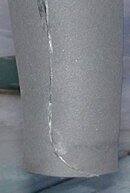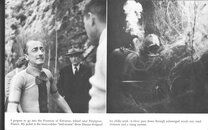This post verifies a need for a historical correct dive book
FYI
The wet suit was accidentially discovered in a swimming pool in San Diego.
I was declared "Top Secret" by the NDC--the Koren War was in full swing
It was released to the civilian market in mid 1950s
EDCO made the first commerical wet suit
Soon most of the local dive shops began making wet suits
Neoprene (rubber) sheets were WW11 surplus,
Purchased from Kirkhoff rubber company-
Pay the gate guard $1.00 go to the pile and help your self
(I suspect the guard pocketed the $$$$ as a bonus)
Glue was Black Magic
The pattern was to lie down and trace around your body
Cut the sheet with a rolling pizza cutter
Coat the edges with Black Magic and press together
let dry for about 5 minutes
The first nylon lined wet suit was introduced in 1961
US Divers "non terfoam"- white lined- Failure! Urine staining
Parkways -(early Wet suit manufacture), 'NyloPreme' -light blue lined
The Abalone divers of the 13 Street fleet in Newport Beach, Cal. Discovered a local seamstress who for a very reasonable price would whip stich the nylon of the suits together.
The Abalone divers dove very negative, they used 3/8 arms and 1/2 inch body wet suits. It was common practice to force a hose into the wet suit and use their their bodies as lift bags at the end of the day..Often the seams would split..but not after being stiched.
Many local serious divers had their suits stiched--(including me)
Newport was about five miles from US Divers and Voit.
Many employees were LA Co UW instrs,who wore custom stiched suits
The stiching of the suit was investigated and accepted by US Divers
First commerical blind stiched nylon lined wet suits introduced in 1966.
The commerical sewing machine was specially made in Europe--$$$$
US Divers "Super Marine" Black linded with EZ Hooks
White Stag "Permaseam" blind stiched and taped
(Chuck Smiley was the world's best Wet suit maker!--been gone for 20 years)
So yes you can make your own wet suit and you can hand sew it with a blind stich-It has been done many many times in the past-
Note you live in Canada-- If you live near SCUBA 2000 suggest that you visit Alex and discuss wet suits with him.
Tommy, great to see you are back! We should resume the divers flag "discussion."
SDM
the sun is bright; the weather is warm ---I am off to the beach.........






